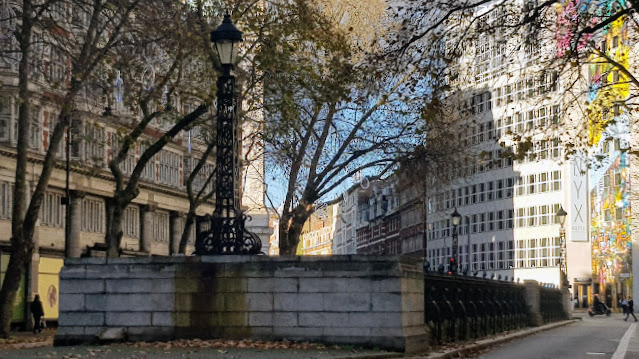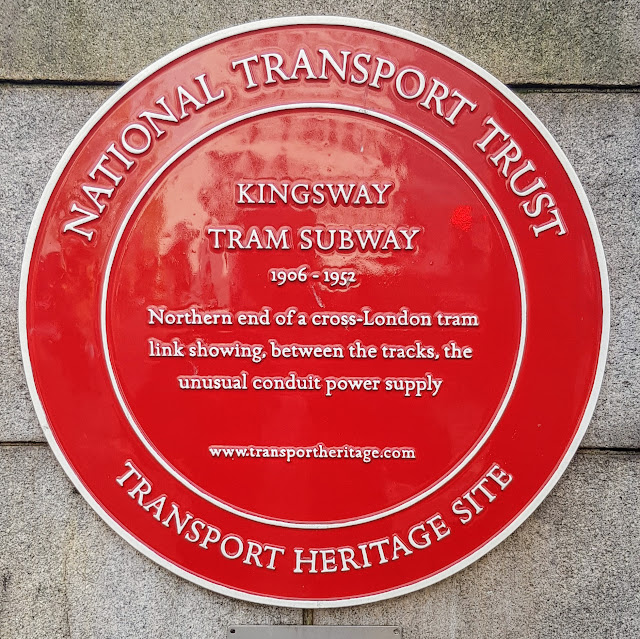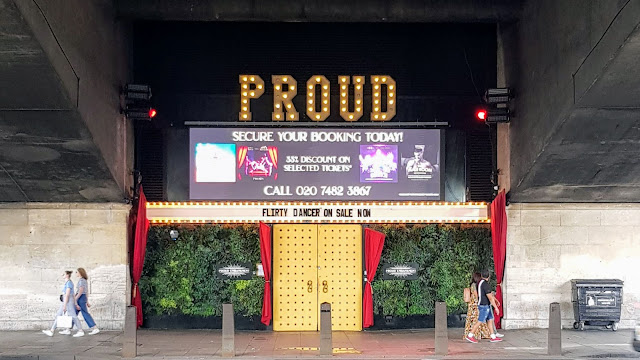 |
| The Kingsway Tram Subway entrance. |
I have walked up and down Southampton Row on numerous occasions, as it is a direct walking route from Euston, when I travel by London Overground, to the River Thames. The road and pavements are always busy as Russell Square, Queen Square, the University of London and much more are all in the area.
As you cross the busy Theobalds Road, there is a ramp, behind iron gates, that slopes down into a tunnel, in the middle of the road. This is the only surviving entrance to the Kingsway Tram Subway.
Unlike the rest of the tram network, which ceased operation in 1952, the Kingsway Tram Subway still has the street tracks, for the most part, in situ. Looking closer you can make out the underground electricity cable that powered this route.Although Southampton Row hasn't really changed that much, over the last century, you can immediately spot a problem with the layout. The roads would have been quieter, granted, but passengers would have to cross to the centre of the road, where stairs would need to be descended to reach the station below. And those exiting the tunnel would climb a different set of stairs, only to find themselves fighting to cross the road to the safety of the pavement.
Services would continue to change as more bridges were modified to take trams, like Blackfriars Bridge in 1909.
With the London Passenger Transport Board being formed in 1933 the death knell was rung for the trams, as the Board wa sin favour of "more modern vehicles".
Following its closure various parts of the tunnel have been used for different roles.
Brief History
In the late 1800s the Holborn area had a considerable number of slums and so, in 1898, it was decided to clear the area and improve the streets. The opportunity also allowed for the connection of the north and south tram lines, which would allow for trams in the north to be serviced at the Charlton Repair Depot.
Using the cut-and-cover method construction began and in 1902.
 |
| Looking back at the Kingsway entrance. |
Opening in 1906 the tram ran from Angel to Aldwych, with the route being extended north to Highbury, in November of that year.
In 1908 the tram had through services from Highbury to Embankment, where the tunnel portal was situated at the side of Waterloo Bridge Here the line split with one heading to Westminster Bridge and on to Kennington Gate, and the other heading to Bloomsbury and the Hop Exchange, via Tower Bridge. The Bloomsbury route only ran until 1930, when it was discontinued.
When the tramway opened its trams were all single-deck. This would change in 1929 when, realising that to remain profitable they needed more customers, double-deck trams were requested.
However, to accommodate these larger trams works were required on the tunnel. This included the replacement of the roofs cast iron tubes with steel girder supported roof. The trackbed was lowered, in some places, by 5 feet with concrete also used for the underpinning of the walls
In 1932 a weekend service ran between Highgate and Downham via Brockley, with a total distance of 16 miles, making it the County of London's longest tram route.
In 1932 a weekend service ran between Highgate and Downham via Brockley, with a total distance of 16 miles, making it the County of London's longest tram route.
 |
| Transport Heritage Plaque. |
With the London Passenger Transport Board being formed in 1933 the death knell was rung for the trams, as the Board wa sin favour of "more modern vehicles".
Between 1935 and 1940 many tram lines were replaced mostly by Trolleybuses.
In 1937 Waterloo Bridge was being rebuilt, which required the moving of the tramway entrance to beneath the Bridge.
Following the conclusion of World War II, it was decided that diesel buses should replace the last of the trams "as soon as possible".
On Saturday April 5, 1952, the last tram left the Kingsway Tramway Tunnel.
 |
| The southern portal of the Kingsway Tram Subway, beneath Waterloo Bridge. |
The southern portal of the tunnel is now a bar, which involved the removal of the pedestrian walkways and the reinforcing the bridge's undercroft.
It is possible that many people have driven through the tram tunnel, too, as some of the southern tunnel is now part of the Strand Underpass.
The London Transport Museum do 'Hidden London' trips, occasionally, to the Kingsway Tram Tunnel, so it was worth signing up to their newsletter to find out when tickets will be available.
No comments:
Post a Comment